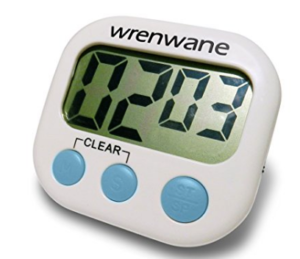As I introduce more positive behavior tools I want to stress the importance of a TIMER. Next to laminating and using the word “flexible”, a timer is something I use all the time. And I don’t think I can stress the word all enough. I use a timer with Buddha when he needs to complete tasks like homework, reading, doing dishes or even when he needs to shower. I find timers are effective for four main reasons:
- It keeps your child on task– When a child is given a task with no time frame they usually slack off or forget about it. Having a timer keeps them going because they want to finish the task before they hear that beep.
- It requires less nagging and reminding– Instead of constantly reminding your kids to finish a task you want them to do, all you have to say is “You have 2 minutes left”
- It helps with independence– The main goal for my students is independence. I want them to be able to complete tasks on their own from homework to brushing their teeth. Once you use a timer enough, you can ask your children to use it on their own. You’ll be surprised at how much they can get done!
- It’s fun- Turn using a timer into a game. Ask your kids how much time they think they need to finish a task and respond by saying “Yeah? I bet you can do it in just __ minutes”.
How to use it:
- Introduce the timer. Explain how it will work and even model it if need be. Make it clear that different tasks will have different times.
- Use the timer as much as you can.
- Go over the time frame before beginning the activity. For example, say: “You can play outside for 10 minutes. I’m going to set the time and once it goes off you have to come in”.
- Give reminders. Make sure to remind your kids when the timer is getting low. You don’t want to add extra stress, but it is very helpful when a child knows how much time they have left. Especially if your child has a hard time with transitions (i.e. getting out of the pool, switching from iPad to reading). A simple “Hey, there is 1 minutes left” will make all the difference.
- Give positive praise! When they complete a task before the timer goes off celebrate it. It’s hard to do, so give them the praise they deserve.
- As always, be consistent. Use the timer as much as possible and remember, once the timer goes off, that’s the end. Try not to add more time.
Here is a video of me using a timer with Buddha. I tell him the set time before he begins playing and I use reminders as the timer gets closer to the end. This task would have been near impossible 6 months ago. The transition from a fun activity to work was very difficult for Buddha, but using a timer made things so much easier.
Below are two links to timers that work great with kids. The first is a basic timer, while the second is more visual.
Note- Your phone or watch can be just as effective, but it’s better to use a visual clock with your child first before moving onto a timer that only you can see.
Timer 1:
Timer 2:


